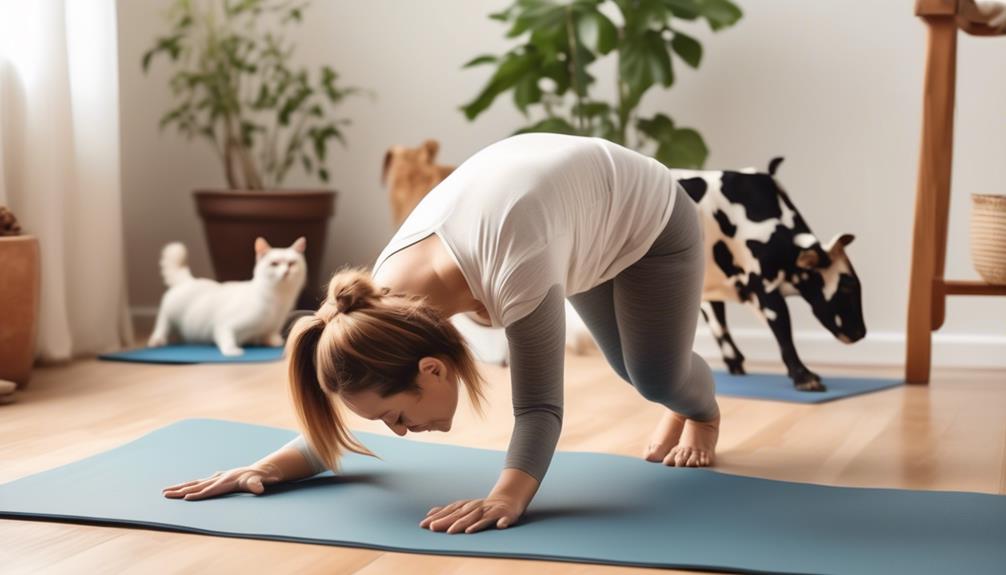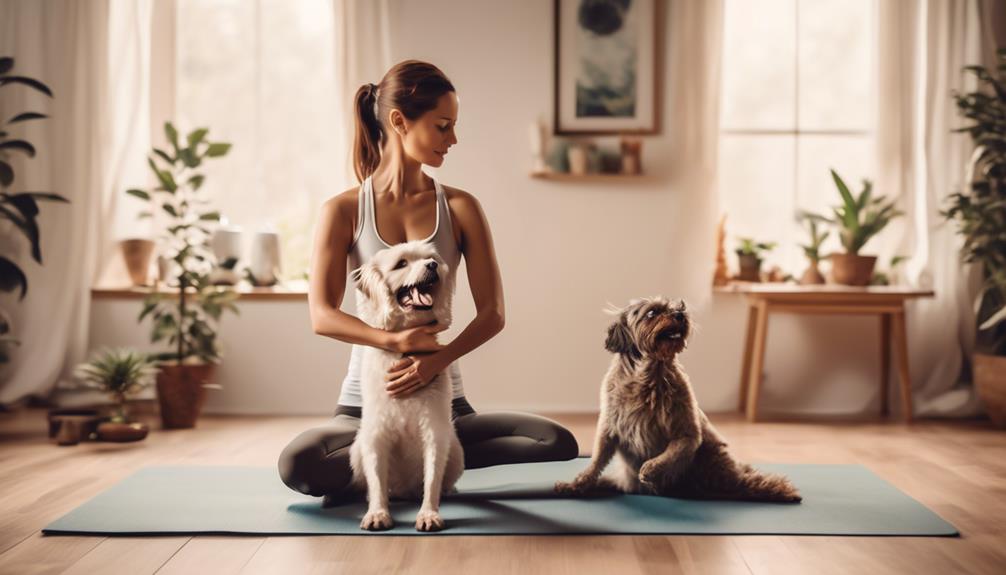Why Mindfulness in Pets Can Be Achieved Through Yoga

Yoga can help pets achieve mindfulness and inner calm. It does so by reducing anxiety and stress levels. Additionally, it provides physical exercise and mental stimulation. Lastly, it promotes a deep connection between pet and owner.
Key Takeaways
- Yoga can help pets achieve mindfulness by focusing on breath, movements, and sensations.
- The mind-body connection in pets affects their physical and mental health, and yoga promotes balance and harmony.
- Yoga poses for pets, such as downward dog and cat-cow, enhance their physical well-being and promote mental relaxation.
- Creating a peaceful yoga environment for pets involves providing enough space, removing potential hazards, and incorporating calming scents.
The Benefits of Yoga for Pets
Yoga offers a multitude of benefits for pets, enhancing their overall well-being and promoting a state of mindfulness. Incorporating yoga into pet training and introducing it to animals in shelters can have a significant positive impact on their physical and mental health.
One of the key benefits of yoga for pets is increased flexibility and strength. Just like humans, animals can experience improved muscle tone and range of motion through regular yoga practice. This can be especially beneficial for older pets or those recovering from injuries.
Yoga also helps to reduce stress and anxiety in pets. The calming and meditative aspects of yoga can help animals to relax and find a sense of inner peace. This is particularly important for pets in shelters, who may have experienced trauma or abandonment. By incorporating yoga into their routine, these animals can find solace and learn to trust again.
Furthermore, yoga can improve the bond between pets and their owners or caretakers. The practice of yoga requires focus and communication, which can strengthen the connection and understanding between humans and animals. This can be especially helpful in pet training, as yoga teaches both parties to listen to each other's cues and work together harmoniously.
How Yoga Promotes Mindfulness in Pets

Through the practice of yoga, pets can develop a heightened sense of mindfulness and awareness. Yoga promotes mindfulness in pets by improving their behavior and promoting relaxation. By engaging in yoga poses and practicing deep breathing exercises, pets can experience a range of physical and mental benefits that contribute to their overall well-being.
One way that yoga promotes mindfulness in pets is by improving their behavior. Pets that practice yoga are more likely to exhibit calm and focused behavior, as the practice encourages them to be present and in the moment. Through the physical movements and stretching involved in yoga poses, pets can release pent-up energy and reduce anxiety, which can lead to improved behavior and a greater sense of calm.
Additionally, yoga promotes relaxation in pets by helping them to release tension and stress. The slow and deliberate movements in yoga encourage pets to relax their muscles and focus on their breath, promoting a state of relaxation and tranquility. This can be particularly beneficial for pets that experience anxiety or have a tendency to become easily stressed.
To summarize, practicing yoga can promote mindfulness in pets by improving their behavior and promoting relaxation. By incorporating yoga into their routine, pets can experience increased awareness, improved behavior, and a greater sense of calm and relaxation.
Understanding the Mind-Body Connection in Pets

Pets that engage in yoga can develop a deeper understanding of the mind-body connection, which plays a crucial role in their overall well-being. Mindfulness exercises and meditation techniques incorporated in yoga can help pets become more aware of their physical sensations, emotions, and thoughts, enabling them to achieve a state of balance and harmony.
The mind-body connection refers to the relationship between the mind and the body, where mental and emotional states can affect physical health and vice versa. In pets, this connection is just as significant as it's in humans. When pets engage in yoga, they learn to focus on their breath, body movements, and sensations, which helps them to be present in the moment and develop a heightened awareness of their physical and mental states.
Through mindfulness exercises, pets can learn to recognize and release tension or discomfort in their bodies. This can be particularly beneficial for pets with chronic pain or anxiety issues. By incorporating meditation techniques, such as deep breathing and visualization, pets can learn to calm their minds and reduce stress levels. This can have a positive impact on their overall well-being, promoting relaxation, improved sleep, and better emotional regulation.
Understanding the mind-body connection in pets is essential for their overall health and happiness. Yoga provides a holistic approach that allows pets to develop this understanding and cultivate a sense of mindfulness. By engaging in regular mindfulness exercises and meditation techniques, pets can experience improved physical and mental well-being, leading to a happier and healthier life.
Techniques for Introducing Yoga to Your Pet

Introducing yoga to your pet can be done through a variety of techniques that aim to promote relaxation and mindfulness. These techniques can help your pet experience the benefits of yoga and improve their overall well-being.
Here are three effective methods for introducing yoga to your furry friend:
- Gentle Stretching: Start by gently stretching your pet's body, focusing on their limbs and spine. This will help increase their flexibility and prepare them for more advanced yoga poses. Use slow and controlled movements, being mindful of your pet's comfort and limitations.
- Guided Breathing: Teach your pet to focus on their breath by guiding them through deep breathing exercises. Sit comfortably with your pet and encourage them to take slow, deep breaths. You can use a calming voice or play soft music to create a soothing atmosphere. This technique helps in reducing stress and promoting relaxation.
- Partner Poses: Engage in partner poses with your pet to build a stronger bond and make the yoga practice more enjoyable. For example, try the 'Downward-Facing Dog' pose with your dog or the 'Cat-Cow' pose with your cat. These poses not only provide physical benefits but also create a sense of connection between you and your pet.
Yoga Poses for Pets: A Beginner's Guide

The incorporation of yoga poses into a pet's routine can provide numerous benefits for their physical and mental well-being. Practicing yoga with pets isn't only a fun and interactive way to bond with them, but it also promotes relaxation, flexibility, and strength.
While pets may not be able to perform complex poses like humans, there are several simple and safe yoga poses that can be introduced to them.
One beginner-friendly pose is the downward dog. This pose helps stretch and strengthen the muscles in the back and legs. To do this pose, the pet starts in a standing position, then stretches their front legs forward and their back legs backward, forming an upside-down 'V' shape.
Another pose that pets can try is the cat-cow pose. This pose helps improve spinal flexibility and can be particularly beneficial for pets with back problems. To do this pose, the pet starts on all fours and alternates between arching their back upwards like a cat and lowering their belly towards the ground like a cow.
Practicing yoga with pets not only enhances their physical well-being but also promotes mental relaxation and reduces stress. Incorporating these simple yoga poses into a pet's routine can be a great way to improve their overall health and well-being.
Overcoming Challenges in Practicing Yoga With Pets

While practicing yoga with pets can be a rewarding experience, there are certain challenges that owners may encounter. Incorporating pets into yoga routines, especially with cats, can present unique obstacles that need to be overcome. Here are three common challenges and some strategies to address them:
- Distraction: Pets, especially cats, are naturally curious creatures and may find the yoga session to be an opportunity for playtime. This can lead to distractions and disruptions in your practice. To overcome this challenge, it's important to create a designated space for your pet, with toys and treats, to keep them engaged and occupied during your yoga session.
- Interference: Pets may attempt to join you on your yoga mat, making it difficult to perform certain poses or maintain balance. It's essential to set boundaries and establish a separate space for your pet to prevent interference. You can use a nearby mat or cushion for your pet to relax on while you focus on your practice.
- Safety concerns: Pets can sometimes get underfoot or accidentally scratch or bite during yoga movements. It's crucial to ensure the safety of both you and your pet by keeping a close eye on their behavior and being aware of their presence at all times. Additionally, trimming your pet's nails regularly can help minimize the risk of accidental injury.
Tips for Creating a Peaceful Yoga Environment for Your Pet

Creating a peaceful yoga environment for your pet can greatly enhance their mindfulness and relaxation during your practice. When setting up your yoga space, it's important to consider your pet's comfort and well-being.
To create a pet-friendly space, ensure that there's enough room for your pet to move around and explore without feeling restricted. Clear any potential hazards from the area, such as sharp objects or unstable furniture, to prevent accidents. Additionally, provide a comfortable mat or cushion for your pet to lie on, so they can join you in your practice.
Incorporating calming scents can also contribute to a peaceful yoga environment for your pet. Certain scents, such as lavender or chamomile, are known for their relaxing properties and can help create a soothing atmosphere. You can use essential oils or scented candles, but be sure to choose pet-safe options and keep them at a safe distance from your pet to avoid any accidental contact or ingestion.
Remember to introduce your pet to the yoga space gradually, allowing them to explore and get comfortable with the new environment. Offer positive reinforcement and rewards to encourage their participation and relaxation.
Frequently Asked Questions
Can Yoga Help My Pet With Anxiety or Stress?
Yoga can help pets with anxiety and stress. It has been shown to reduce separation anxiety and provide benefits for pets with PTSD. Regular practice can promote mindfulness and relaxation, improving their overall well-being.
Is It Safe for All Pets to Practice Yoga?
Practicing yoga with pets can have potential risks and precautions. However, the benefits of yoga for pets, such as reducing anxiety and stress, outweigh the risks when done safely and with proper guidance.
How Often Should I Practice Yoga With My Pet?
Practicing yoga with pets can be beneficial for both the owner and the pet. Regular practice can help foster a sense of mindfulness and relaxation. However, the frequency of practice should be tailored to the individual pet's needs and abilities.
Can Yoga Help Improve My Pet's Flexibility and Mobility?
Yoga can significantly enhance a pet's flexibility and mobility, leading to improved physical health. The practice offers numerous benefits, such as increased range of motion and strengthened muscles, which contribute to overall well-being.
Are There Any Specific Yoga Poses That Are Beneficial for Pets With Certain Health Conditions?
Yoga poses for pets with arthritis and respiratory conditions can provide various benefits. These poses can help improve flexibility, reduce inflammation, and enhance breathing. Incorporating yoga into their routine can promote overall physical and mental well-being.









